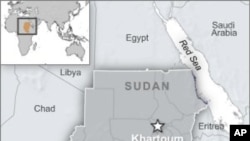Newly independent South Sudan is one of the poorest countries in the world with some of the worst health statistics. Most people in the vast, rural nation will never visit a health center. But at the country’s leading hospital in the capital Juba, doctors say that patients who make it here often die due to a lack of blood. American doctors are now working to set up a system of “virtual” blood donors while the hospital battles a lack of power, storage and cultural barriers to set up a real blood bank.
In Juba Teaching Hospital’s Emergency Ward, the beds are packed and the light dim despite this being a day where the power is on in a city that suffers shortages for days at a time.
At the hospital’s laboratory, the only room that is powered by a backup generator, a handful of people wait to donate blood to their relatives. A family-size fridge in the corner contains around 20 pints of blood mostly designated for specific patients due for surgery.
Thirty-five-year-old Amin Gerald has come to donate blood for his wife who is scheduled for an operation to solve reproductive problems. A nurse at Torit Hospital, about six hours from here, Gerald often deals with patients that don’t understand the importance of giving blood.
He says taboos about blood donation in South Sudan often run stronger than ties to their nearest and dearest, and he is only “sacrificing himself” for his partner now as there is no one else to donate.
“According to what I’ve been learning from them, they believe that giving somebody blood is different blood altogether. How come it will mix itself to your own to make you survive? Unless the person is told the details and importance of that one, that’s why he or she can accept to give the blood, but not necessarily,” Gerald said.
In addition to varying tribal beliefs, doctors say they face widespread fears that sharing blood is unnatural and will make you sick, and relatives often refuse to give blood to dying loved ones.
When they do, lab technicians have a fight on their hands to try to give blood to patients in desperate need over others for which it has been donated. They say too many people are dying unnecessarily.
Matthew Fentress is a doctor from Harvard University hospital in the United States who is working in the emergency ward here. He says that the lack of resources and awareness about blood donation are major setbacks to trying to build a real blood bank.
To try to combat this, Fentress and other doctors have set up a “virtual blood bank” of volunteers already screened who can come in at short notice to replenish stocks.
He hopes the initiative will allow blood in the small fridge to be diverted to emergencies and stop the doctors having to watch patients die needlessly in emergencies or even common cases of anemia and malaria.
“It’s very, very difficult when we see that happening and we can’t , I mean if we don’t have the blood, there’s not much we can do for them. It grew out of seeing that and it started out with a couple of colleagues who said gosh, if you ever need blood just call me. So we did that once and then thought, why don’t we expand that and have more people on a list who would give blood? We’re small now but we’re going to expand,” Fentress said.
Doctor Kuma Chuol says that bleeding is the number one cause of maternal mortality in the hospital and hopes the scheme expands.
“It is just the beginning and I hope it succeeds. But I think they need assistance from the communities. There must be medical education or health education for the communities so that they accept to come and donate freely so that we have enough blood in our blood bank,” Chuol said.
Laboratory staff say that in addition to concerns about contracting diseases from donating, patients often don’t want to go through the blood screening process in fear they might discover they have an existing disease. Those testing positive for HIV often flee the scene instead of seeking treatment.
A central blood bank that can hold up to 200 pints is being built at the hospital next year. But unless taboos are broken down, filling it will be a big challenge.
Virtual Blood Donors to Rescue South Sudan Patients













